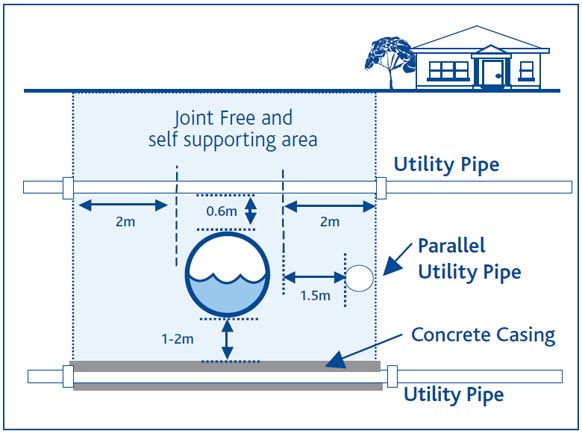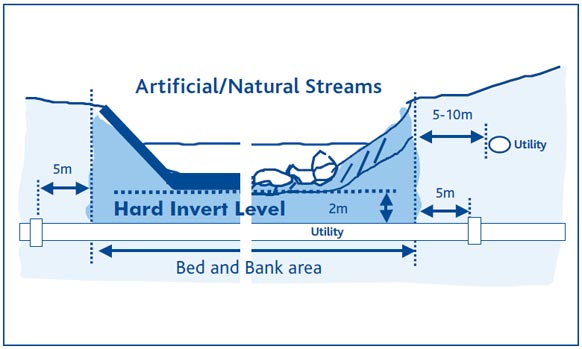Our guidelines outline our technical requirements for utility installations aligned across or in parallel to our sewage and stormwater pipes, water mains and natural or artificial channels.
For information on underground pipes, cables or other assets, call Dial Before You Dig or visit their website.
Clearance requirements
When setting clearances, consider the installation method, soil conditions, and asset type, size and age.
Clearances should be measured as follows.
| Clearance type | Point measured from |
|---|---|
| All clearances | Outside surfaces of pipe or channel walls (not from centrelines or inner wall surfaces) |
| Vertical clearances for natural streams | Base of the hard invert level |
See our separate clearance guidelines for:
Build over a drain, easement or other structure
Plant near sewers, drains and water mains
Underground assets
Open cut excavations
This involves:
-
excavating soil to form a trench
-
laying, repairing or removing the utility infrastructure
-
backfilling the trench
For all open cut excavations you must:
-
ensure a 1 metre minimum vertical clearance between the utility and our asset
-
construct concrete cut-offs
-
compact soil to 95–98%
-
return the ground surface to its original condition
Passing over pipes
When passing over pipes you must:
-
ensure that any utility is self-supporting to allow for future maintenance on our assets
-
set a minimum vertical clearance of 0.6 metres above our assets
-
ensure that no joints sit within 2 metres of our assets, that is, within the joint free area (refer to diagram)
Passing under pipes
When passing under pipes you must:
-
case utility pipes in concrete or a similar protective material
-
ensure a minimum clearance of 1 metre for open cut and 2 metres for boring installation methods
-
ensure that no joints sit within 2 metres of our assets, that is, within the joint free area (refer to diagram)

Waterways and constructed channels
Boring
Boring involves drilling a small tunnel through soil to lay the new utility infrastructure. It is the preferred method for work near our waterways.
If boring is not possible you must submit the following documents to us with your alternative proposal:
-
geotechnical survey
-
environmental report
When boring you must:
-
supply engineering calculations with your application for approval to confirm that there is no soil up or down thrust
-
ensure there is no settlement, such as air pockets left after the installation
-
ensure a minimum vertical clearance of 2 metres, measured from the hard invert level of the waterway/channel bed
-
ensure that manholes and parallel utilities have a horizontal clearance of 5–10 metres from the bed and bank area to allow for future channel/waterway maintenance
-
ensure that no joints sit under the channel/waterway or within 5 metres of the bed and bank area
-
meet any legal requirements for significant flora, fauna and archaeological sites
-
minimise disturbance to waterways, land and vegetation and reinstate or replant any affected areas when the work is completed

Workplace safety
If you are installing utilities under or near natural or artificial waterways you must provide the following information to us with your application:
-
method of waterway/stream diversion
-
evacuation procedures for people and machinery if there is heavy rainfall or flooding
-
evidence of Victorian WorkCover Authority compliance
Apply online
Apply to install utilities near sewers, drains and water mains
Your feedback
Contact us with any comment or queries:
- call 131 722
- contact us online